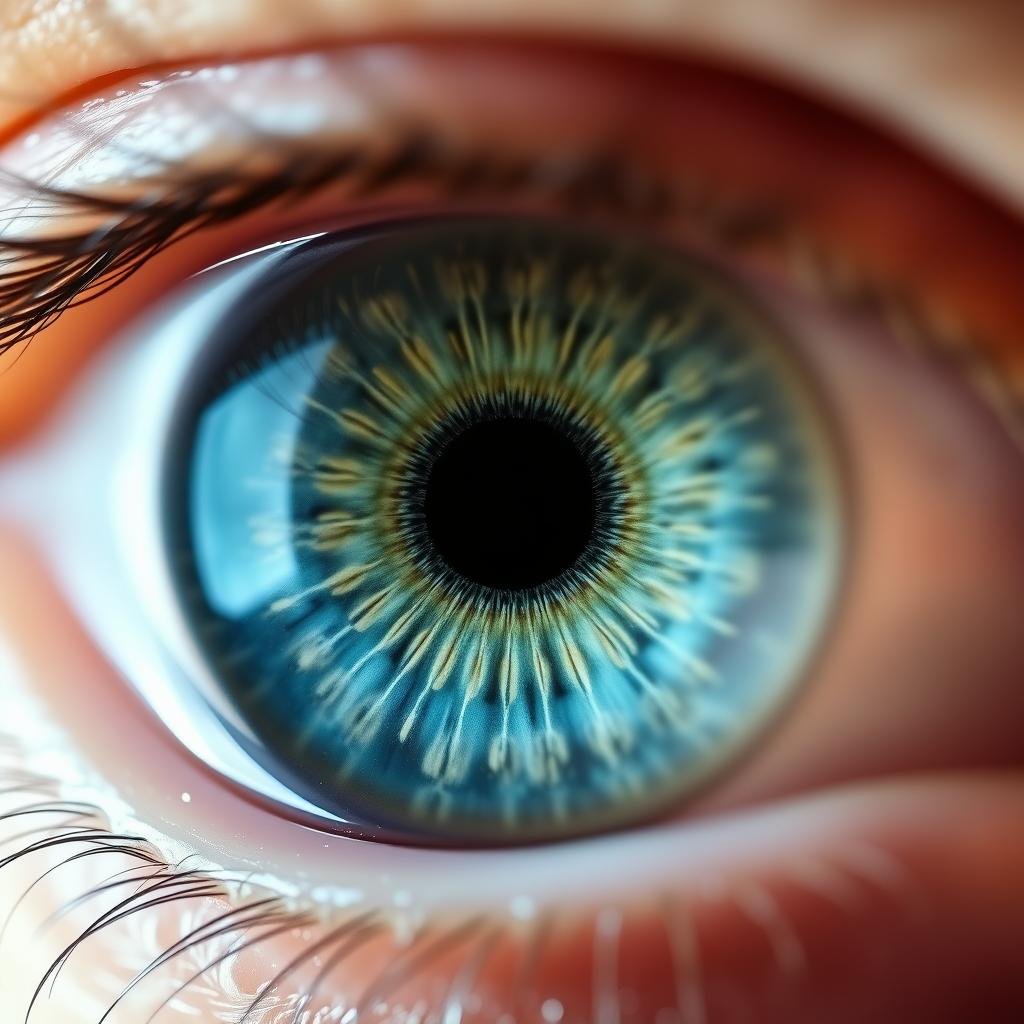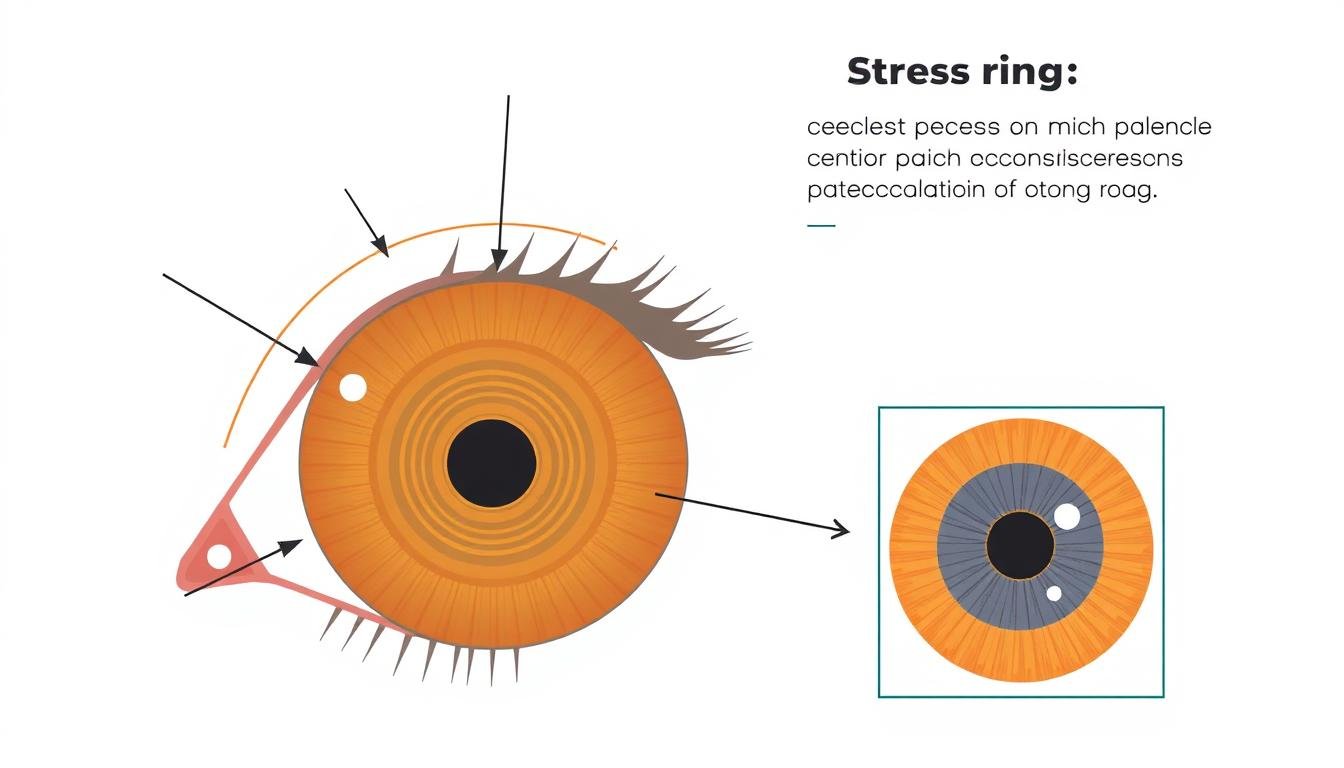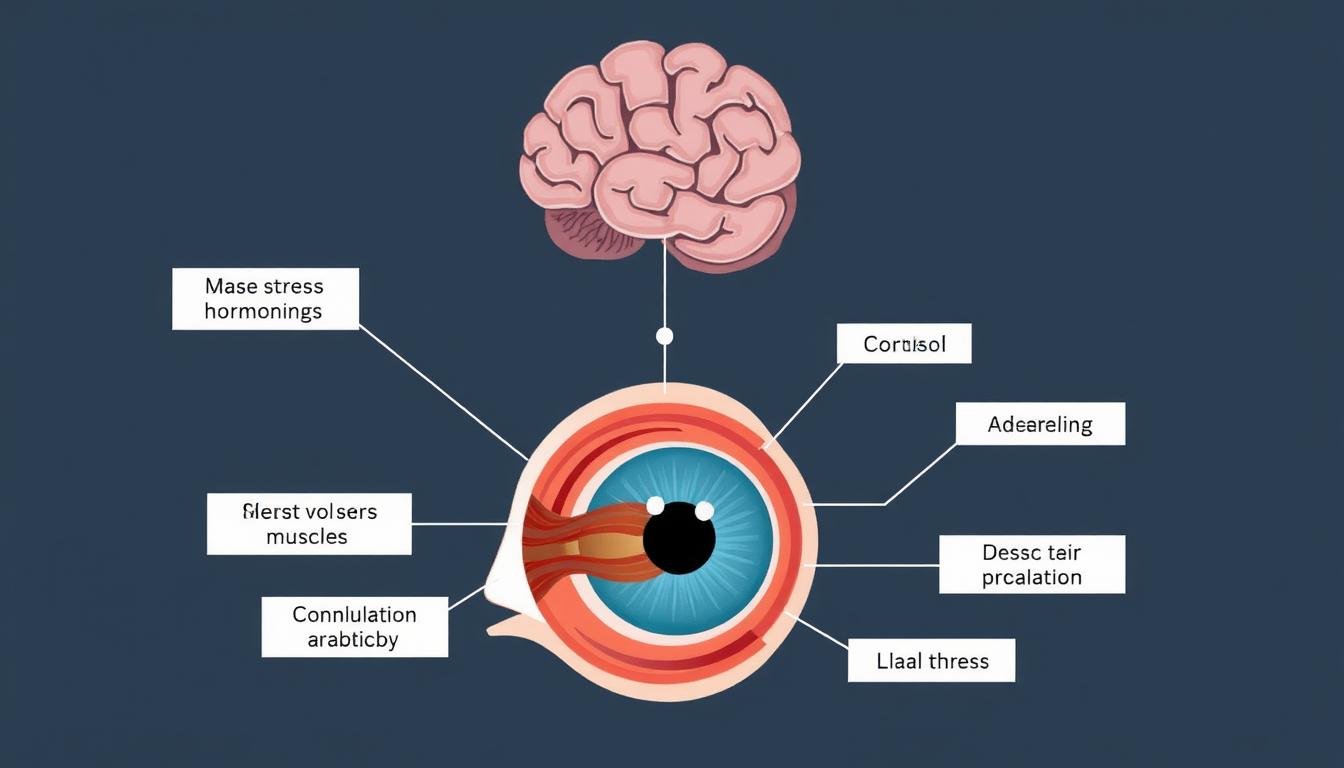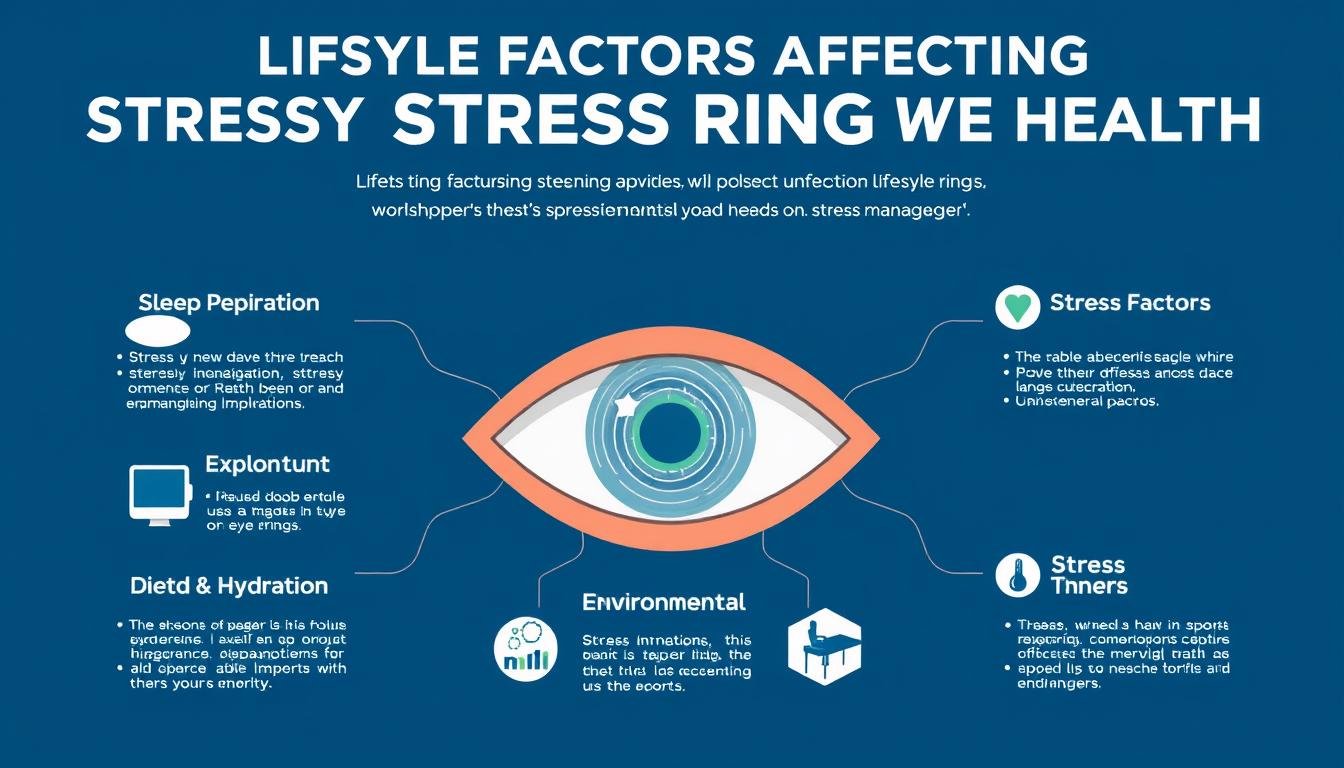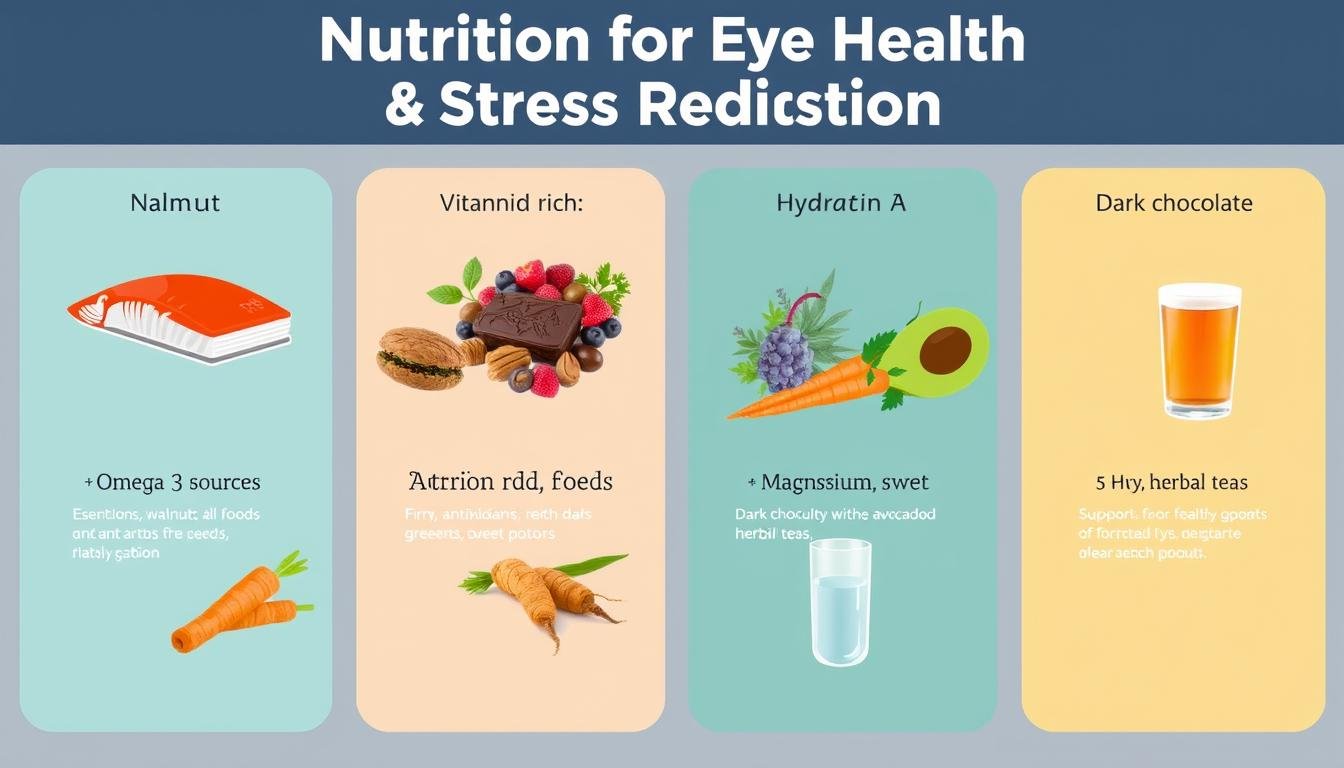Have you ever noticed circular rings or patterns in your eyes during periods of high stress? These distinctive markings, known as stress rings or contraction furrows, can be visible indicators of your body’s response to anxiety and chronic tension. Understanding the connection between these ocular signs and your mental wellbeing offers valuable insights into how stress manifests physically. In this comprehensive guide, we’ll explore the science behind استرس در چشم حلقه می کند, their relationship to anxiety, and effective strategies to address both the visible symptoms and underlying causes.حلقه های استرس در چشم چیست؟
Stress rings appear as circular patterns surrounding the pupil in the iris
Stress rings, also known as contraction furrows or nerve rings in iridology, are circular lines or indentations that appear in the iris of the eye. These rings manifest as darker or lighter curved bands that partially or completely surround the pupil. They can vary in number, visibility, and prominence depending on the individual’s iris color and the level of stress they’re experiencing.
In the field of iridology—a holistic practice that studies iris patterns to assess health—these rings are considered physical manifestations of chronic nervous tension. They form due to the buckling of iris fibers caused by prolonged stress, representing what practitioners describe as a state of neurovascular dysfunction in the body.
The Formation of Stress Rings
Stress rings develop through a physiological process related to your body’s stress response. When you experience chronic anxiety or tension, your autonomic nervous system remains in a heightened state of alertness. This persistent activation affects various bodily systems, including the tiny muscles that control your iris.
The sphincter and dilator muscles of the iris can become chronically tense, causing the fibrous structure of the iris to buckle or compress. Over time, this creates the visible circular patterns we identify as stress rings. The more pronounced these rings appear, the greater the indication of chronic stress impact on your nervous system.
The Physiological Link Between Stress, Anxiety and Eye Health
The connection between stress rings in your eyes and anxiety is rooted in your body’s physiological stress response. When you experience anxiety, your body activates the sympathetic nervous system—the “fight or flight” response—triggering a cascade of hormonal and physical changes that affect multiple organs, including your eyes.
Hormonal Mechanisms
During periods of stress, your body releases stress hormones like cortisol and adrenaline. These hormones prepare your body to respond to perceived threats by increasing heart rate, blood pressure, and muscle tension. Your eyes, containing numerous tiny blood vessels and muscles, are particularly sensitive to these hormonal fluctuations.
Elevated cortisol levels can affect the muscles controlling your iris, leading to the formation of stress rings. Additionally, these hormones can impact tear production and eye moisture, contributing to symptoms like dry eyes that often accompany stress-related eye conditions.
Vascular Changes
Anxiety and chronic stress affect blood flow throughout your body, including the delicate vascular networks in your eyes. Persistent stress can lead to vasoconstriction (narrowing of blood vessels) in the eyes, potentially reducing oxygen supply to ocular tissues and contributing to the formation of stress rings.
These vascular changes may also manifest as redness, eye strain, or increased sensitivity to light—common complaints among individuals experiencing high stress and anxiety levels. The combination of muscular tension and vascular changes creates the perfect conditions for stress rings to develop in the iris.
“The eyes don’t just reflect our emotions—they physically respond to our stress levels through measurable changes in pupil dilation, muscle tension, and blood flow patterns.”
— Journal of Ocular Physiology
Medical Recognition of Stress Rings
While stress rings are widely recognized in holistic practices like iridology, their status in conventional medicine presents a more nuanced picture. Understanding the current scientific perspective helps contextualize these ocular manifestations within broader health frameworks.
Current Research and Expert Opinions
Conventional ophthalmology doesn’t typically diagnose or treat stress rings as a specific medical condition. However, research in psychoneuroimmunology—the study of how psychological processes influence our nervous and immune systems—increasingly acknowledges connections between chronic stress and physical manifestations throughout the body, including the eyes.
A study published in the Journal of Psychosomatic Research found correlations between reported stress levels and certain ocular changes, though the specific mechanism of stress ring formation requires further investigation. Researchers noted that individuals with high stress scores showed more pronounced iris texture changes compared to control groups.
Bridging Traditional and Holistic Perspectives
While conventional medicine may not diagnose conditions based on iris patterns alone, many integrative health practitioners consider stress rings valuable indicators of chronic tension. Dr. Bernard Jensen, a pioneer in American iridology, documented correlations between iris markings and stress-related conditions in thousands of patients throughout his clinical practice.
Today, some forward-thinking medical professionals are beginning to incorporate aspects of these observations into more holistic patient assessments, recognizing that visible changes in the eyes can sometimes provide early indications of stress-related health concerns before they manifest as diagnosable conditions.
Research Note: A 2018 study in the International Journal of Complementary & Alternative Medicine found that 78% of participants with diagnosed anxiety disorders displayed visible stress rings in their irises, compared to 31% in the non-anxious control group.
Free Stress Assessment Guide
Discover your personal stress profile and learn targeted techniques to reduce anxiety symptoms. Our comprehensive guide includes a self-assessment tool and customized recommendations.
دانلود راهنمای رایگان
Symptoms of Stress-Related Eye Issues
Stress and anxiety don’t just create visible rings in your iris—they can manifest through various ocular symptoms that affect your comfort and vision. Recognizing these signs helps you identify when stress might be impacting your eye health.

Primary Ocular Symptoms
- Stress Rings/Contraction Furrows: Visible circular patterns in the iris that may increase in number or prominence during periods of high stress
- Eye Strain: Persistent feeling of tiredness or discomfort in the eyes, especially after focusing on screens or detailed work
- Dry Eyes: Reduced tear production leading to irritation, scratchiness, and discomfort
- Blurred Vision: Temporary visual disturbances that may come and go with stress levels
- Light Sensitivity: Increased discomfort when exposed to bright lights or glare
Associated Physical Symptoms
- Tension Headaches: Often beginning behind the eyes or at the temples
- Eyelid Twitching: Involuntary spasms of the eyelid muscles (myokymia)
- Redness: Dilated blood vessels in the whites of the eyes
- Dark Circles: Increased prominence of under-eye shadows
- Pupil Changes: Fluctuations in pupil size or responsiveness
How Stress Rings Differ From Other Eye Conditions
It’s important to distinguish stress rings from other eye conditions that may present with similar symptoms. Unlike conjunctivitis (pink eye) or allergic reactions that primarily affect the whites of the eyes, stress rings specifically appear in the iris. They also differ from arcus senilis (age-related white rings around the cornea) or glaucoma-related changes that affect different eye structures.
While many eye conditions require medical intervention, stress rings often respond well to stress management techniques and lifestyle adjustments. However, any persistent eye symptoms should be evaluated by an eye care professional to rule out other potential causes.
Lifestyle Factors That Worsen Stress Rings and Anxiety
Several aspects of modern living can exacerbate both the visible manifestation of stress rings in your eyes and the underlying anxiety that contributes to their formation. Understanding these factors helps you identify potential triggers in your daily routine.
Sleep Deprivation
Insufficient sleep significantly impacts both your stress levels and eye health. During sleep, your body repairs tissues and processes stress hormones. When you don’t get adequate rest, cortisol levels remain elevated, intensifying anxiety symptoms and potentially worsening stress rings.
Research shows that even one night of poor sleep can increase stress reactivity by up to 60%. For your eyes specifically, sleep deprivation reduces tear production, increases inflammation, and may enhance the visibility of stress rings by affecting iris muscle tension.
Digital Screen Exposure
The average American spends over 7 hours daily on digital devices, creating perfect conditions for digital eye strain. Extended screen time reduces blink rate by up to 60%, leading to dry eyes and increased ocular stress. The blue light emitted by screens may also disrupt sleep patterns, creating a cycle that worsens both anxiety and eye symptoms.
The constant visual focusing and refocusing required when using digital devices places additional strain on eye muscles, potentially contributing to the formation and prominence of stress rings, especially when combined with the mental stress of constant connectivity.
Dietary Factors
- Caffeine Overconsumption: Increases cortisol production and can heighten anxiety
- Refined Sugar: Creates blood sugar fluctuations that may trigger stress responses
- Alcohol: Disrupts sleep quality and dehydrates the body, including the eyes
- Dehydration: Reduces tear production and overall eye moisture
- Nutrient Deficiencies: Lack of omega-3s, vitamin A, and antioxidants affects eye health
Environmental Stressors
- Poor Air Quality: Irritates eyes and increases overall physiological stress
- Harsh Lighting: Creates eye strain and can trigger stress responses
- Noise Pollution: Elevates stress hormones even during sleep
- Cluttered Spaces: Visually overwhelming environments increase cognitive load
- Weather Changes: Barometric pressure fluctuations can affect eye comfort
نکته مهم: While lifestyle factors significantly influence stress rings and anxiety symptoms, persistent or severe eye changes should always be evaluated by a healthcare professional to rule out other medical conditions.
Actionable Tips to Reduce Stress Rings
Addressing stress rings requires a two-pronged approach: managing the underlying anxiety that contributes to their formation and implementing specific practices to support eye health. These evidence-based strategies can help reduce both the visible manifestations and their root causes.
تکنیک های مدیریت استرس
Mindfulness Meditation
Regular meditation practice has been shown to reduce cortisol levels by up to 20%. Start with just 5 minutes daily, focusing on your breath. As you become more comfortable, gradually increase to 15-20 minutes. Apps like Calm or Headspace offer guided sessions specifically designed for anxiety reduction.
Deep Breathing Exercises
The 4-7-8 breathing technique (inhale for 4 counts, hold for 7, exhale for 8) activates your parasympathetic nervous system, counteracting the stress response. Practice this technique 2-3 times daily, especially during high-stress periods, to help reduce the physiological tension that contributes to stress rings.
Progressive Muscle Relaxation
This technique involves systematically tensing and releasing muscle groups to reduce physical tension. Pay special attention to the muscles around your eyes and forehead. Practice for 10 minutes before bed to improve sleep quality and reduce overall stress levels.
Eye-Specific Care Practices

The 20-20-20 Rule
When using digital devices, follow the 20-20-20 rule: every 20 minutes, look at something 20 feet away for at least 20 seconds. This simple practice reduces eye muscle fatigue and helps prevent the tension that can contribute to stress rings.
Eye Palming
Rub your palms together to generate warmth, then gently place them over your closed eyes without applying pressure. The darkness and warmth help relax eye muscles and reduce tension. Practice for 1-2 minutes several times throughout the day.
Proper Hydration
Aim for at least 8 glasses of water daily to support tear production and overall eye moisture. Consider using a humidifier in dry environments to prevent eye dryness that can exacerbate stress-related symptoms.
Eye Massage
Gently massage the area around your eyes, including your temples and the bridge of your nose, using small circular motions. This improves circulation and releases tension in the surrounding muscles. Use light pressure and perform for 30 seconds to 1 minute.
Blue Light Protection
Consider using blue light filtering glasses when using digital devices, especially in the evening. Many devices also offer built-in blue light filters or “night mode” settings that can reduce eye strain during extended screen time.
حمایت غذایی
Incorporate foods rich in omega-3 fatty acids (salmon, walnuts), antioxidants (colorful fruits and vegetables), and vitamin A (carrots, sweet potatoes) to support overall eye health and resilience to stress-related changes.

When to Consult a Healthcare Professional
While many stress-related eye symptoms can be managed with self-care strategies, certain situations warrant professional medical attention. Knowing when to seek help ensures that potentially serious conditions aren’t overlooked.
Warning Signs That Require Medical Evaluation
- Sudden Changes in Vision: Blurriness, double vision, or visual disturbances that appear rapidly
- Severe Eye Pain: Intense discomfort that doesn’t respond to rest or over-the-counter remedies
- Extreme Redness: Pronounced bloodshot appearance, especially if accompanied by discharge
- Light Flashes or Floaters: Particularly if they appear suddenly or increase in frequency
- Persistent Headaches: Especially those centered behind the eyes or accompanied by vision changes
- Changes in Pupil Size or Reactivity: Unequal pupils or poor response to light changes
- Halos Around Lights: Colored rings or halos around light sources
- Persistent Dry Eyes: Severe dryness that doesn’t improve with artificial tears
- Eye Symptoms with Severe Anxiety: When eye issues coincide with debilitating anxiety symptoms
- New Medications: Eye changes that occur after starting new medications
Types of Healthcare Providers to Consider
Ophthalmologist
A medical doctor specializing in eye and vision care who can diagnose and treat eye diseases, perform surgeries, and prescribe medications. Seek an ophthalmologist for any potentially serious eye conditions or when you need a comprehensive medical evaluation of eye symptoms.
Optometrist
A healthcare professional who provides primary vision care, including sight testing and correction, and the diagnosis and management of vision changes. An optometrist can detect many eye conditions and refer to specialists when necessary.
Mental Health Professional
When eye symptoms are strongly connected to anxiety, consulting a psychologist or psychiatrist may help address the underlying psychological factors. Cognitive-behavioral therapy and other approaches can effectively reduce anxiety that contributes to physical symptoms.
Integrative Approach: Consider practitioners who take a holistic view of the mind-body connection. Some healthcare providers combine conventional medical approaches with complementary strategies to address both the physical manifestations and psychological components of stress-related eye conditions.
Understanding the Mind-Eye Connection
Stress rings in the eyes represent a fascinating intersection of psychological well-being and physical health. These visible markers remind us that our bodies respond to emotional states in tangible, observable ways. By recognizing stress rings as potential indicators of chronic tension, we gain another tool for monitoring our overall wellness.
The connection between stress rings and anxiety highlights the importance of addressing health holistically. Rather than treating symptoms in isolation, consider how emotional states, lifestyle factors, and physical manifestations interact. This integrated perspective offers the most effective path to reducing both the visible signs of stress in your eyes and the underlying anxiety that contributes to their formation.
Remember that while self-care strategies can significantly improve many stress-related eye symptoms, persistent or severe changes warrant professional evaluation. By combining mindful awareness, targeted lifestyle adjustments, and appropriate medical care when needed, you can support both your eye health and emotional well-being for the long term.
Expert Consultation for Stress-Related Eye Concerns
Struggling with stress rings or other anxiety-related eye symptoms? Our specialists combine conventional and holistic approaches to address both the physical and emotional aspects of your condition.
Book a complimentary 15-minute consultation (valued at $99) to discuss your specific concerns and develop a personalized plan.
Book Your Free Consultation
Can stress rings in the eyes be reversed?
Yes, stress rings can often improve with proper management of underlying anxiety and specific eye care practices. While long-standing rings may not disappear completely, their prominence typically reduces as stress levels decrease and healthy habits are maintained. Consistency with stress reduction techniques and eye relaxation practices is key to seeing improvement over time.
Are stress rings in eyes more common in certain eye colors?
Stress rings can appear in eyes of any color, but they’re often more visible in lighter-colored irises such as blue, green, or hazel. This is simply due to contrast—the rings stand out more clearly against lighter backgrounds. In darker brown eyes, the rings are still present but may require specialized lighting or magnification to observe clearly.
How quickly can stress rings form after periods of anxiety?
The formation of stress rings typically occurs gradually over time with chronic stress exposure rather than appearing suddenly after acute anxiety episodes. However, existing rings may become more pronounced during periods of heightened stress. It generally takes weeks to months of persistent tension for new rings to become visible, which is why they’re considered indicators of long-term rather than short-term stress.

